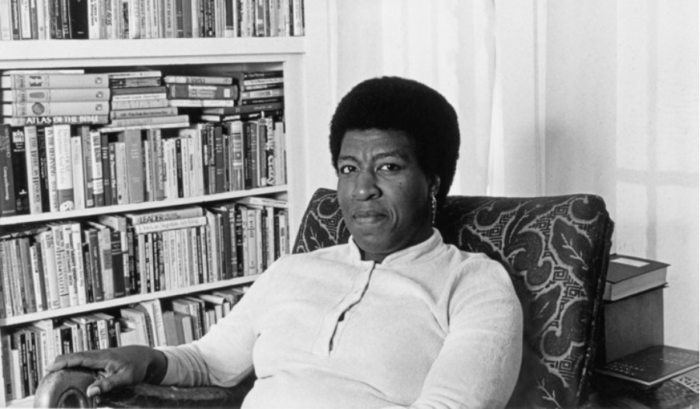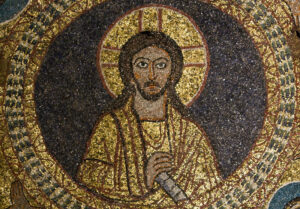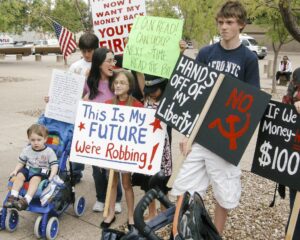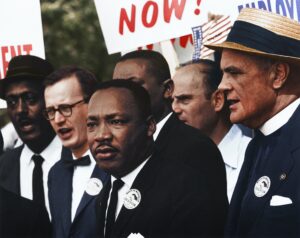Three years ago, at the beginning of the Trump Era, Abby Aguirre wrote in The New Yorker about the prescience of Octavia E. Butler’s novels Parable of the Sower and Parable of the Talents. Aguirre points out that Butler anticipated a presidential candidate eerily similar to Trump: he promised to create jobs (and didn’t), dismantle government programs (and did), and – more chillingly – to Make America Great Again. It is difficult, if not outright impossible, to recall last year’s wildfires in California or this year’s continent-spanning blazes in Australia and avoid the conclusion that Butler was right about politics and ecology in equal measure. Climate models certainly don’t give us much hope for a change within the next four years. The incumbent president’s “joking unless I’m not joking” remarks about staying in office past 2024 add to the fear that we may already be living in the world Butler imagined.
The central protagonist in Butler’s novels is Lauren Oya Olamina, a young woman at the outset of Sower, which is set in 2024. In the California of Butler’s imagining, economic collapse follows ecological collapse, with neighborhoods turning inward for survival, erecting walls and defending land and food by force of arms. Catastrophe visits Olamina’s neighborhood through a destructive raid by those walled-out of the community. She and a few survivors escape to attempt the journey to the San Francisco Bay area on foot, as gasoline and motorized transport are impossibly rare.
Butler’s work is receiving its due, albeit belatedly, with the rising public interest in Afrofuturism and in Black women’s voices in science fiction. Contemporary authors like N.K. Jemisin and Nnedi Okorafor have carried on a tradition of social critique through speculative fiction that centers Black women’s experiences. Such centering brings to mind the work of Womanist ethicists and theologians and the possibility of a resonance between their and Butler’s work. Butler’s prophetic fiction can be further augmented by reading it through the lenses of Christian socialist and Womanist ethics.
The question these thinkers raise is, how possible is social cooperation in late- to end-stage Capitalism? Butler’s answer relies on insider/outsider distinctions: those inside the community have access to mutual aid and support, but those on the outside of the walls are feared when they are not ignored. Neighborhood citizens take turns on armed patrol to keep out the poorest, frequently drug-addicted, residents of the larger city. They have taken over the repressive work of a municipal police force, defending both people and property by threat of violence.
The wall around Olamina’s neighborhood provides very real demarcation of the border between “inside” and “outside” a community of concern. Those outside the boundary wall are there either because they were not fortunate enough to have been community members before the collapse of society or because they committed an irresolvable offense against or threatened the stability of the community. Insider mutuality is reserved exclusively for members of the community in good standing, and exile is a real, and deadly, possibility. Cooperation is possible, but there is an impenetrable ceiling to it.
Even this amount of mutuality and solidarity is not permitted to exist, however, and the walls do indeed come tumbling down. We’re left with a bit of a quandary about this original community: did it fall because the vicissitudes of Capitalism would not allow cooperation to exist, or did it fall because the community was too insular and therefore itself participated in hierarchical oppression and exclusion? Delores S. Williams’s Sisters in the Wilderness may provide an answer. In placing Womanism–a theological and biblical hermeneutic that centers the concerns of Black women in an intersectional analysis including class, race, and gender–in dialogue with White Feminism, Williams gives us a nuanced understanding of how patriarchy functions.
Williams contends that White Feminism functions as the handmaiden to patriarchy by demanding the servitude and surrogacy of Black women. She shows how, historically, White women gained freedom by impressing their unwanted labor onto Black women. Black women became surrogate mothers through both enslaved and domestic labor so that White women could pursue their interests in the worlds of politics and labor. Black women were subjected to sexual violence and portrayed as sexually wanton “Jezebels” to preserve an image of White female purity.
With that in mind, the feminism created by White women cannot possibly fulfill the needs of Black women. Black women find themselves doubly-excluded and doubly-oppressed by both their race and their gender in a White patriarchal society that White feminists unwittingly or unwillingly uphold by ignoring the intersection of class and race in gender politics. Interpreting the fall of Olamina’s original neighborhood through Williams, we see that the neighborhood itself, even though it is broadly non-hierarchical and ethnically diverse, participates in the kind of patriarchy that must be dismantled. It does so by the brutal exclusion of those with less, whether they are the homeless or drug addicted who never made it into community or the exiles who lost access to it, making its own fall necessary for the building of a real community of mutuality.
Butler initially names this new community after the religion that Olamina invents along her journey: Earthseed. During the precarious and physically vulnerable journey northward, Olamina welcomes others into her community on the caveat that they agree to uphold its tenets. Those tenets are based on a shared understanding of humanity’s ultimate vulnerability. Olamina declares in no uncertain terms that God is change, and further that God-as-change is not constrained to Christian ideas of morality and goodness. While on the road, the community is highly vulnerable; however, they create a defensive perimeter not of exclusive barriers but of inclusion and mutuality. A barrier wall like the one Olamina had in her old neighborhood is impossible to move with a group on the road.
Beyond that impossibility, though, is a possibility for a better way to protect a community. If a community is vulnerable because it possesses something that an outsider does not have and will commit violence to gain, does it not make sense to domesticate the stranger by bringing them into the community? Olamina and Earthseed commit to a way of including outsiders that simultaneously provides this kind of defense against the threat of violence that these same strangers entail. Strangers are welcomed into the community and it grows, but there is a vulnerable necessity to that growth. Will the strangers commit to Earthseed’s goals or will they take what they want once inside and leave the community bereft? Without greater numbers, the community will fail or be destroyed. To risk this destruction by pursuing inclusive and mutual relationships is, perhaps, the most Christian thing about the early Earthseed community.
In Making a Way Out of No Way, Monica A. Coleman devotes an entire chapter to analysis and appreciation of the Parable novels. She sees the Earthseed community as a prophetic image for the future of humanity. For Coleman, this community also serves as a critique of the present order. Parable of the Sower critiques our present society by imagining the dystopian outcome of our current political moment: political division leading to instability and deleterious withdrawal of central authority, economic inequality leading to the return of overt slavery, and ecological collapse leading to increasingly destructive wildfires in California. Sadly, the last of these is already happening. Coleman looks to Butler, and to Black women’s science fiction more broadly, as a space in which better possible futures can be imagined.
Without this prophetic imagination, we have only either the unsatisfactory present or the troubled past to appeal to in thinking about what the Kingdom of God should look like. Instead of looking backward to feudal kingdoms or combing through various imperfect and compromised political systems that exist now, Coleman insists that we can look to authors like Butler for models of how that Kingdom might be built. Earthseed stands out in this bleak future like the first crocus through the last of winter’s snow: it is the possibility of beauty and flourishing breaking out of the barrenness of the present.
Through Williams’s intersectional Womanist analysis of linked and overlapping oppressions and Coleman’s embrace of science fiction as prophetic literature, we can see Butler’s work as a necessary, and regrettably prescient, critique of our moment[1]. We cannot rely on being the second-slowest gazelle in order to escape the ravenous lion at our heels, as Olamina’s first community did. We must embrace the kind of mutuality in vulnerability that the Earthseed community builds during their journey. That mutuality has had many names in history, but the one I prefer is anarcho-syndicalism, a socialistic form of anarchism that does away with the state in favor of small communities of mutual aid and concern, governed by radical and direct democratic decision-making.
Subverting vulnerability into strength may be many things as well, but I prefer to think of it as a fundamentally Christian ethical disposition. May we learn the lesson Butler tried to teach us before we prove her irrefutably right in her prediction.
[1] There are two unavoidable ironies that must be addressed openly in writing this piece. The first is that I make no claim either explicitly or by implication that this work is itself a piece of Womanist thought or scholarship. I am a White male, and Womanism–however much I appreciate its insights–is not mine to claim as an outlook. What I mean to do here is to highlight points of affinity that I see between Butler on the one hand and Williams and Coleman on the other. The second is more deeply ironic and perhaps must remain in unresolved and paradoxical tension. I have pointed to Williams’s rejection of surrogacy as an important point that helps to analyze Butler’s work in a Womanist light. At the same time, it could easily be argued that I have relied on Butler’s emotional labor in imagining a future to which I can respond as a kind of surrogacy. Whether such surrogacy is indivisible from authorship is certainly a point that could be debated. I mean here to acknowledge the possibility of appropriation rather than appreciation.
Peter Herman writers theology to oppose Whiteness and White supremacy, drawing on speculative fiction to either imagine a better world or to understand what’s wrong in this one. He is often angry about things on Twitter at @hermaneutic.




